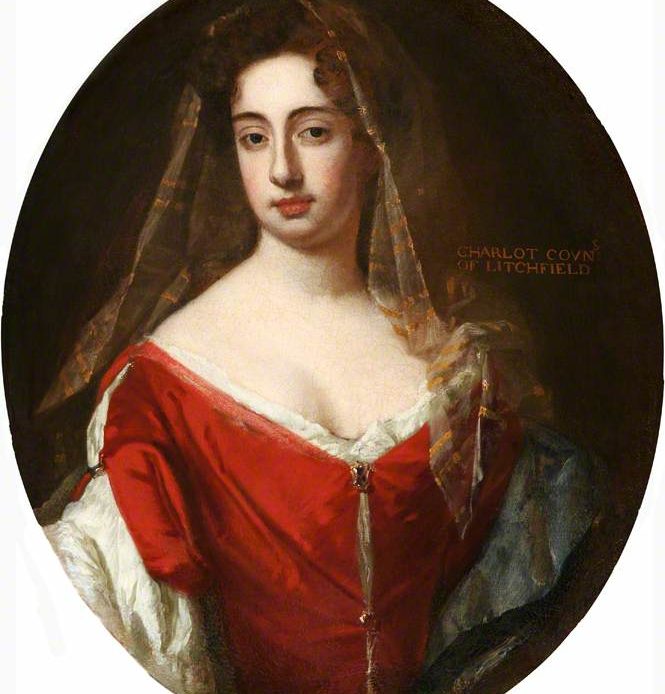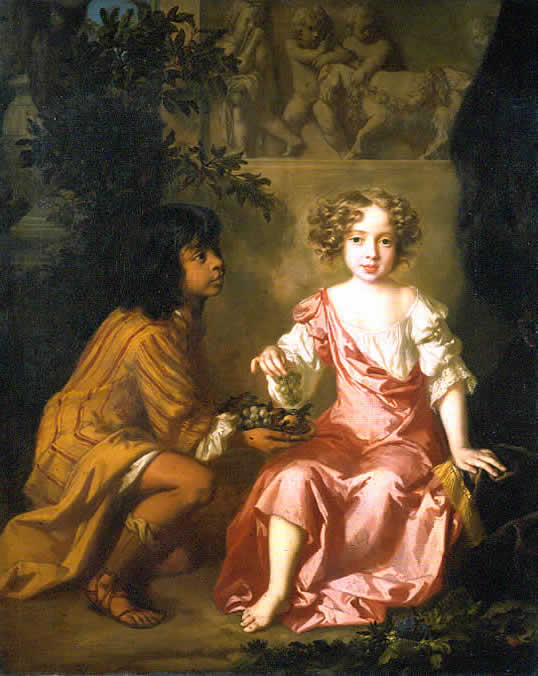
Lady Charlotte Fitzroy, was – as her name suggests – the daughter of a King, but not by his queen. Charles II’s queen, the Portuguese-born Catherine of Braganza, was apparently barren and miscarried after six years of childless marriage in 1688. This is something which would have been made more painful by the knowledge of the King’s illegitimate children, for example, those by Barbara Villiers, Countess of Southampton and Duchess of Cleveland, referred to by Pepys as ‘Lady Castlemaine’ in his famous Restoration Diary. Amongst this brood of illegitimate children by his numerous mistresses in their time, Charles II maintained Barbara Villiers as a favoured mistress from around 1660 onwards, before she was eventually replaced by Louise de Keroualle, Duchess of Portsmouth “the most absolute of the King’s mistresses”. Of Barbara’s six children, at least five were acknowledged by the King as his own, although each of the six would eventually bear the old quasi-royal name of Fitzroy, meaning “son of the king”, which in turn can mean a son or daughter of a king and has remained in use by some descendants.
Barbara’s first daughter, whom her husband Roger Palmer owned as her at birth, but whom the King acknowledged officially as his when she married, was the Lady Anne Palmer, born in 1661; although an alternative theory ascribed her paternity to the 2nd Earl of Chesterfield. Charles Palmer, the 2nd Duke of Cleveland, was born in 1662; Barbara was painted holding him, in imitation of the Madonna and child, by Sir Peter Lely. Henry Fitzroy, Earl of Euston and Duke of Grafton, was Barbara’s second son by the King, born in 1663. George Fitzroy, Duke of Northumberland, was her third and last son, born in 1665. Between her two brothers Henry and George, a second girl was born, who the King acknowledged. She was destined to be his favourite daughter. Her name was Charlotte Fitzroy, a name which pays double tribute to her royal parentage – Charlotte an obvious choice from Charles, Charlotte not coming properly into England until the next century.
Charlotte was born on 5 September 1664. As she grew up, she became an important feature within the King’s family, together with her elder sister, Anne. Her uncle, James, Duke of York, the later King James VII/II doted on his niece, something which is proved through the letters they exchanged. Charlotte was painted as a child holding grapes by Sir Peter Lely, in a portrait with her Indian page. Dressed in pink silk and a chemise, she sits in front of a wall after Duquesnoy. The painting took ten years to complete. Once in the collection of Viscount Dillon, it is now in York Art Gallery. As she grew up, various mezzotints were made of her, mostly after Sir Godfrey Kneller. Totally different to her volatile mother, Charlotte seems to have possessed an utter sweetness of nature and a beauty of character.

Perhaps not beautiful in the classical sense, she seems to have inherited something of her mother’s sensuous beauty, without the swarthy features of her father, thought to be traced back to the Medici strain in his French forebears. Charlotte’s face and chin were apparently “too small”, whilst her mouth was said to be like that of Charles II. In the notes he scribbled to Charlotte, she was Charles II’s “dear Charlotte”. Charlotte was not the only Charlotte, however – Charles II had another illegitimate daughter in around 1650 by Elizabeth Killigrew Boyle – Charlotte Jemima Henrietta Maria Fitzroy.
Charlotte was betrothed to Sir Edward Henry Lee in 1674 before she was ten. The pair were married on 6 February 1677, when she was only twelve, and he was thirteen. Sir Edward Lee was made Earl of Lichfield, Viscount Quarrendon and Baron Spelsbury on his union with Charlotte. Among the Lee ancestors was Henry Lee of Ditchley, Queen’s Champion and Master of the Armouries under Queen Elizabeth I. The great Ditchley estate was acquired by Sir Henry Lee in 1580, and Elizabeth I visited him there in 1592. The famous “Ditchley Elizabeth” portrait of Elizabeth I, showing her with her foot on Oxfordshire and the toe touching Ditchley, was painted by Marcus Gheeraerts the Younger as a result of the visit and hung at Ditchley until 1932. It was the son of Sir Edward Lee and Charlotte, the 2nd Earl of Lichfield, who built Ditchley Park in 1722, entrusting the interior decoration to none other than William Kent and also to Henry Flitcroft. Charlotte’s portrait hangs at Ditchley, a pendant to one of her husband, Sir Edward Lee, in the White Drawing Room at Ditchley Park.
The marriage of Charlotte and Edward appears to have been particularly blessed, not least because the couple had at least eighteen children – Charlotte had already four at the age of nineteen. The couple enjoyed a happy life together, something of an anomaly at a time when the personal success of a planned marriage – a King’s daughter being considered desirable – was if anything, a rare exception. Charlotte enjoyed a life of pleasure, liked billiards and basset, rode and decorated her houses. The 4th Earl of Lichfield died without issue, so the Ditchley estate went to his niece Lady Charlotte Lee, who married Henry Lee, 11th Viscount Dillon. The Dillons is a title of Irish peerage. The Dillons retained ownership of the Ditchley Estate until 1932 when the 17th Viscount Dillon died, and Ditchley was sold to the Tree family.
Charlotte outlived her husband by two years, dying in 1718. The couple’s monument is in the parish church of Spelsbury – between Chipping Norton and Charlbury – on the south chancel wall. The tomb is of Carrara marble, with a white marble tablet, bearing the Lee and royal Stuart arms. It pays tribute to the couple’s forty-two years of happy married life: “At their marriage, they were the most grateful bridegroom and the most beautiful bride and that till death they remained the most constant husband and wife”.
©Elizabeth Jane Timms, 2019.

